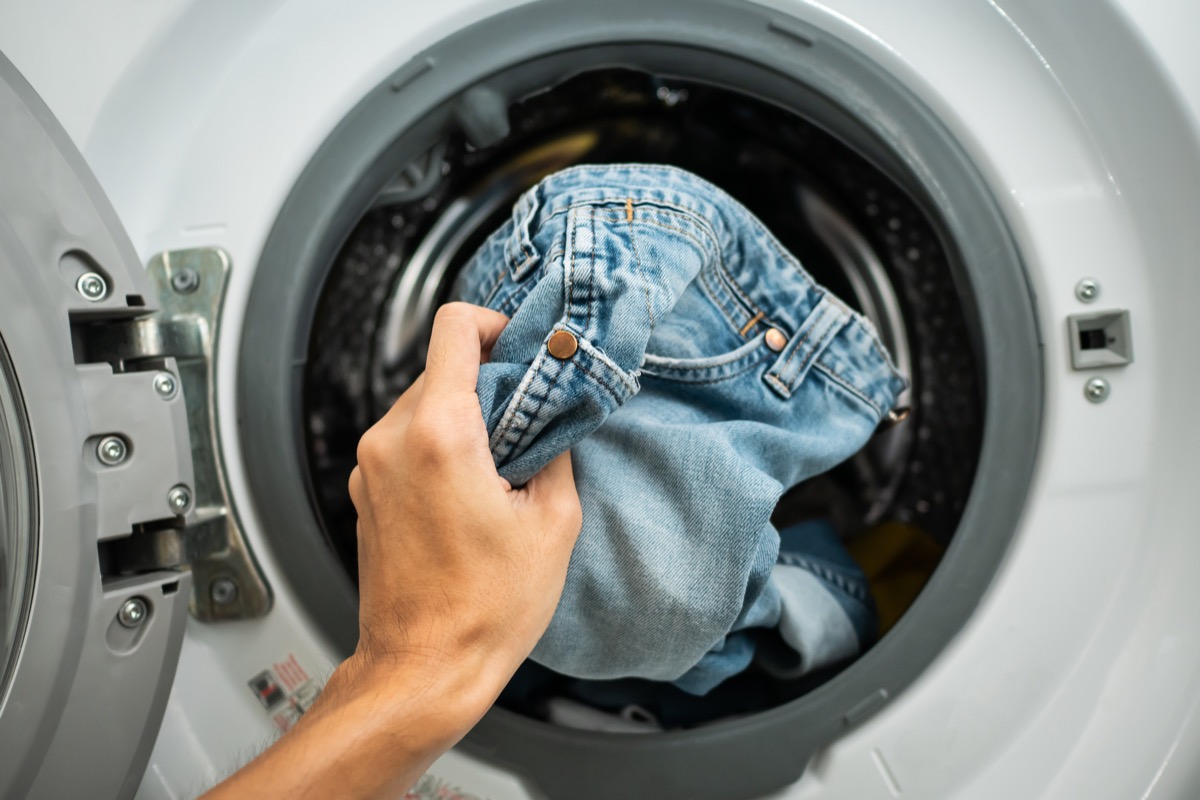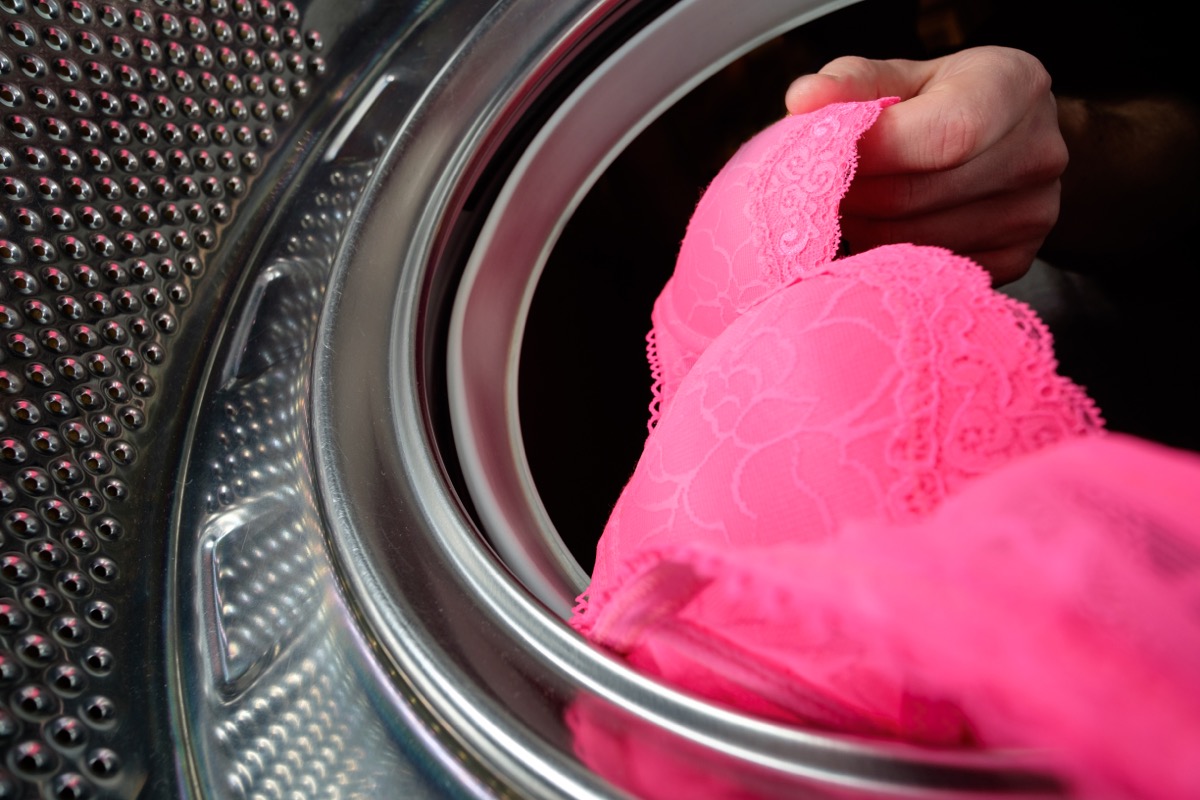5 Clothing Items You're Overwashing, Experts Say
Here's why over-laundering your clothes can backfire.

Laundry day will admittedly go a whole lot faster by throwing the contents of your entire hamper into the washing machine at once. But of course, washing your clothes indiscriminately can also mean accidentally damaging some of your favorite wardrobe pieces. Instead, you're going to need to sort your clothing—by color, yes—but also by how often each item needs to be washed. By pulling out the garments that require a less frequent rinse, you can spare them from unnecessary wear and tear in the spin cycle and dryer. Read on to learn which five clothing items you're putting in the laundry too much, and how to care for them properly going forward.
RELATED: What Happens When You Don't Wash Your Sheets Every Week, Doctors Say.
1
Jeans

Jeans are one of the few clothing items that many people wear on repeat throughout the week—and experts say that's just fine. If your jeans go directly into the hamper after each wear, you're washing them far too often, they tell Best Life.
"Jeans are typically made from durable denim fabric and washing them too often can lead to fading and a loss of shape," explains Max Ciampi, director for the menswear line Savile Row Company. "Frequent washing can also cause the fabric to break down more quickly, leading to a shorter lifespan for your jeans."
To avoid this, Ciampi suggests washing jeans every four to six wears, or when they are visibly soiled or stained.
"Start by turning jeans inside out before washing to preserve their color and use cold water and a gentle cycle to reduce wear and tear," he advises.
2
Bras

Bras are unique in that they typically include both delicate materials and an unforgiving structure. Unfortunately, both the fabric and underwire in a bra can be damaged by washing or drying the item incorrectly or too often.
"Overwashing bras can lead to fabric breakdown, color loss, fraying and damage, weakening of elastic bands, and loss of padding and lining," says Rick Rome, CEO and founder of the on-demand laundry and dry-cleaning service WashClub.
"Most individuals should wash their bras every two to three wears as this helps maintain freshness. Activity level, sweating, and climate can influence how often bras need to be washed. For example, sports bras may need to be washed more often to remove sweat and odors," he notes.
In general, Rome says it's considered best practice to hand-wash bras because this is gentler on delicate fabrics and helps prolong lifespan.
"If bras need to be machine washed, place them in a mesh lingerie bag to protect them from snagging onto other clothes and prevent them from getting misshapen," he advises. "Lastly, if bras need a refresh between washes, you can use lingerie sprays and air them outside instead of a full wash cycle. Bras should not be machine dried, even in low heat, as this can damage the underwire and fabrics. Lay them flat on a towel or hang them on a drying rack to avoid stretching the straps."
RELATED: 21 Ways to Do Laundry in Your Freezer.
3
Sweaters

Experts say that most people should also wash their sweaters less frequently—and take more precautions when they do.
"Sweaters, especially those made of wool or delicate fibers, can lose their shape and become prone to pilling if washed too frequently. Over-washing can also cause shrinkage and increased pilling, especially with delicate fabrics like cashmere," says Ciampi.
To keep them in top condition, you can wash your sweaters with the same frequency as your jeans, every four to six wears unless they're visibly dirty.
"Airing them out between wears is a good way to keep them fresh," Ciampi suggests. "Hand washing is a good method for delicate sweaters, or you can use a gentle cycle with cold water when machine-washing them. Use a mesh laundry bag to protect them from friction."
4
Outerwear

Coats and jackets, especially those with insulation or special coatings, should also be washed sparingly, says Ciampi. He recommends cleaning outerwear only when necessary, such as when visibly soiled or after prolonged use in harsh conditions.
"These shouldn't be washed too frequently, as overwashing can damage insulation, reduce their water repellency, and cause visible wear on zippers and other hardware," he notes.
For more cleaning tips sent directly to your inbox, sign up for our daily newsletter.
5
Swimsuits

How often you wash your swimsuit depends on where you wear it, says Rome. In fact, in some scenarios, it's perfectly acceptable to skip the wash cycle and lay your suit out to dry in the sun.
"Swimwear only requires washing every three to five wears when swimming in freshwater, like a river or lake, or an un-chlorinated pool," Rome explains. "However, when swimming in an ocean, saltwater pool, or chlorine, swimwear should be washed immediately after swimming because these can damage the fabric and cause the color to fade."
When you do wash your suit, Rome recommends using cold water—"hot water can cause the microfibers within the swimwear to stretch"—as well as a mild laundry detergent. This will remove the sand and chlorine from the suit, without damaging the fibers. Light hand washing should also do the trick.
However, Rome advises skipping the dryer cycle when it comes to swimwear. "Machine drying swimsuits in high heat can easily damage the suit and break down the polymer chains within the material. The best way to dry swimsuits is to lay them flat or hang them to drip dry."





















